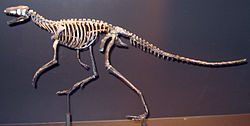Marasuchus
|
Marasuchus Temporal range: Late Triassic, 236–234 Ma |
|
|---|---|
 |
|
| Restored skeleton | |
| Scientific classification | |
| Kingdom: | Animalia |
| Phylum: | Chordata |
| Class: | Reptilia |
| Clade: | Dinosauriformes |
| Genus: |
†Marasuchus Sereno & Arcucci, 1994 |
| Species: | †M. lilloensis |
| Binomial name | |
|
Marasuchus lilloensis (Romer, 1972 [originally Lagosuchus]) |
|
| Synonyms | |
|
|
Marasuchus (meaning "Mara crocodile") is a genus of basal dinosauriform archosaur which lived during the late Triassic in what is now La Rioja Province, Argentina.
Marasuchus was lightly built and small, it had a length of 30–40 cm (1.0–1.3 ft), height of 10 cm (0.3 ft) and weight of 2–5 kilograms (4.4–11.0 lb). It was bipedal, walking with an upright (parasagittal) gait, like that of modern mammals and birds.
One of the diagnostic features of dinosaurs, a hole in the hip socket (acetabulum) of the pelvis for the femur (thighbone), is absent in Marasuchus; however, it possessed characteristics, such as an elongate pubis and the presence of an anterior trochanter on the femur, similar to those found in dinosaurs. The presence of these characteristics in Marasuchus shows that some of the features limited to dinosaurs and their close relatives had begun to evolve in the Middle Triassic prior to the formal origin of dinosaurs in the Late Triassic.
Until 2003 Marasuchus was thought to be one of the closest relatives of the dinosaurs. At present it has been supplanted by other dinosauromorphs such as Silesaurus. Nonetheless, Marasuchus remains an important animal for understanding the origin and evolution of dinosaur characteristics.Cladogram simplified after Nesbitt (2011):
...
Wikipedia
